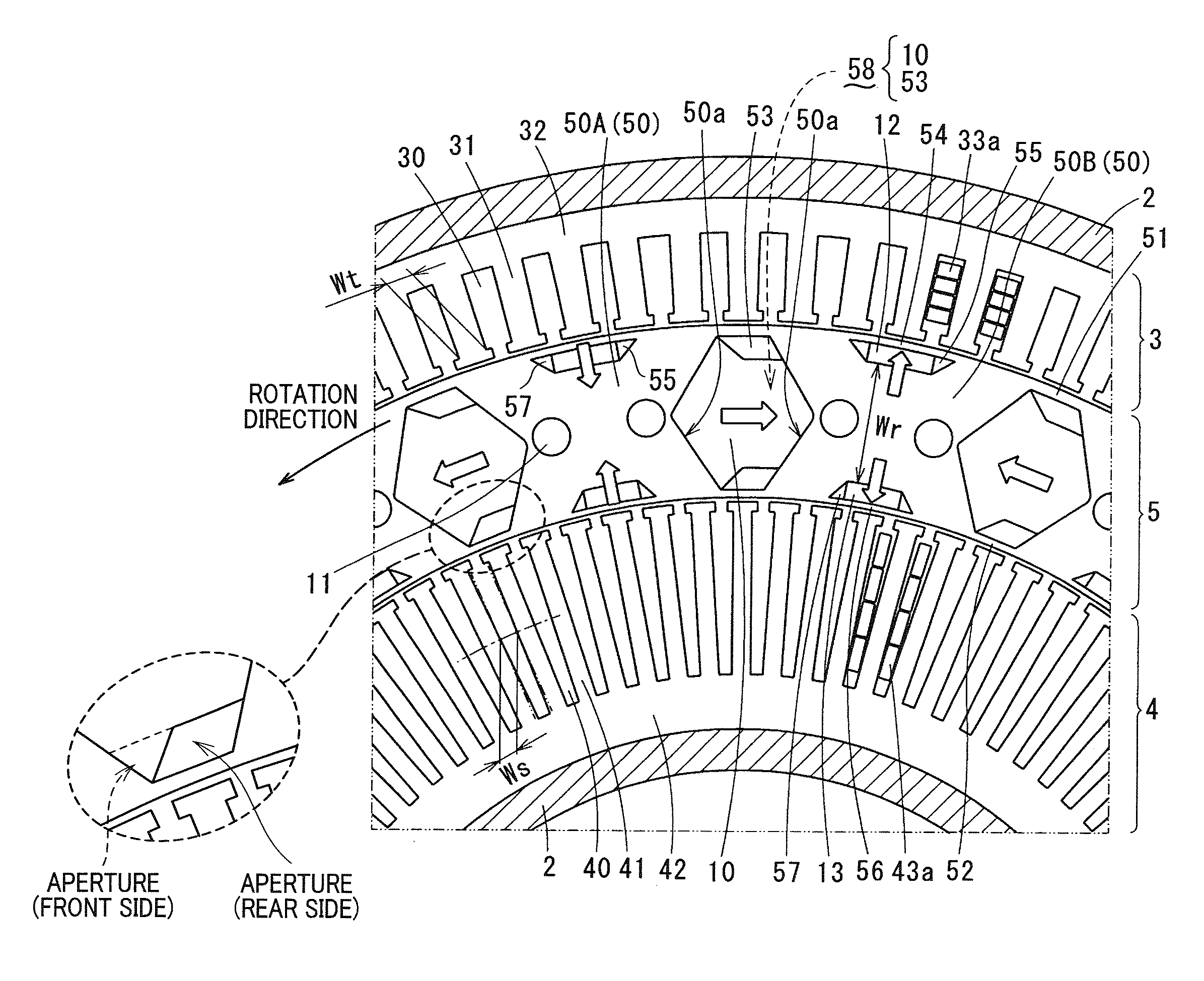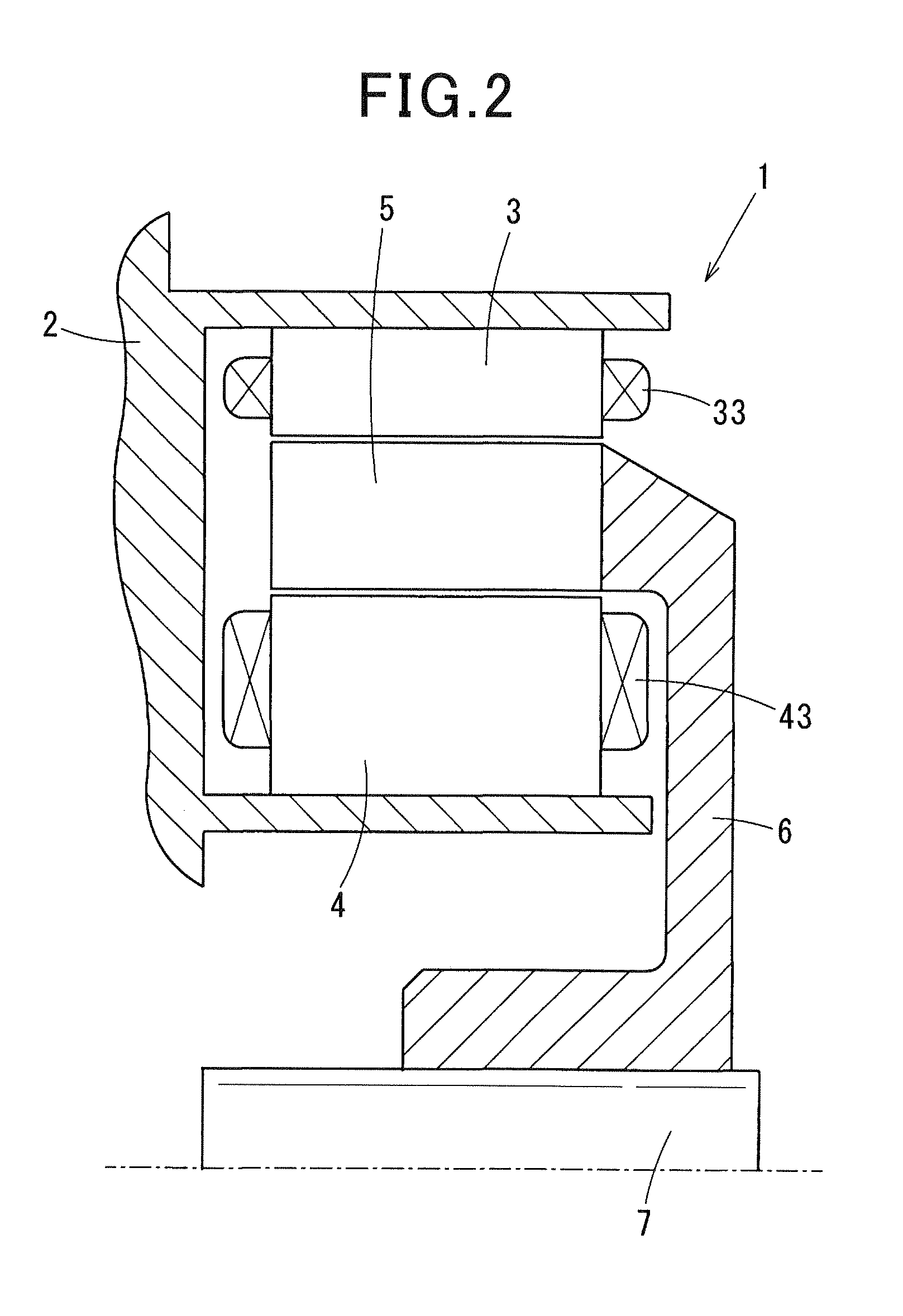Synchronous motor
a synchronous motor and synchronous technology, applied in the direction of dynamo-electric machines, magnetic circuit rotating parts, magnetic circuit shapes/forms/construction, etc., can solve the problem of reducing the output torque of the patent document, difficult in principle for such ferrite magnets to generate a large output torque, and electric motors as the conventional technique disclosed
- Summary
- Abstract
- Description
- Claims
- Application Information
AI Technical Summary
Benefits of technology
Problems solved by technology
Method used
Image
Examples
first exemplary embodiment
[0038]At first, the concept of the present invention relates to a synchronous motor, for example, a double stator synchronous motor. Such a double stator synchronous motor has a rotor and a stator assembly composed of a first stator and a second stator. In a structure of one stator assembly, the first stator and the second stator are arranged at both sides in an axial direction of the rotor. In a structure of the other stator assembly, the first stator is arranged at a radially outside section of the rotor, and the second stator is arranged at a radially inner section of the rotor. The following explanation of the first exemplary embodiment will explain the latter case of the stator assembly in which an outer stator as the first stator is arranged at a radially outside section of the rotor, and an inner stator as the second stator is arranged at a radially inner section of the rotor.
[0039]A description will be given of a double stator synchronous motor 1 according to the first exemp...
second exemplary embodiment
[0136]A description will be given of the double stator synchronous motor according to a second exemplary embodiment with reference to FIG. 6.
[0137]FIG. 6 is a view showing a partial cross section of the double stator synchronous motor according to the second exemplary embodiment of the present invention.
[0138]As shown in FIG. 6, an outer aperture section 53a1 is formed in an overall width area (which is composed of a front side area and a rear side area) between the adjacent segment magnetic poles 50 along a rotation direction of the rotor 5. That is, the outer aperture section 53a1 is formed in an overall width area between the adjacent segment magnetic poles 50, namely, between one segment magnetic pole 50A and the other segment magnetic pole 50B, and also between the magnetic-pole outside bridge 51 (at the upper side) and the buried magnet 10.
[0139]Similar to the outer aperture section 53a1, an inner aperture section 53a2 is formed in an overall width area (which is composed of a...
third exemplary embodiment
[0142]A description will be given of the double stator synchronous motor according to a third exemplary embodiment with reference to FIG. 7.
[0143]FIG. 7 is a view showing a partial cross section of the double stator synchronous motor according to the third exemplary embodiment of the present invention.
[0144]As shown in FIG. 7, the magnetic-pole central magnet 13 is arranged in the inner diameter side of the segment magnetic pole 50.
[0145]The outer magnetic concave section (or an outer magnetic depressed section) is formed on an outer diameter side of the segment magnetic pole 50. The outer magnetic concave section is formed as a concave area 59 from the outermost diameter side toward an inner diameter side. The structure using the concave section 59 makes it possible to concentrate the magnetic-pole central magnet 13, as compared with the structure having both the magnetic-pole central magnet 13 formed at the radially inner side and the magnetic-pole central magnet 12 arranged at th...
PUM
 Login to View More
Login to View More Abstract
Description
Claims
Application Information
 Login to View More
Login to View More - R&D
- Intellectual Property
- Life Sciences
- Materials
- Tech Scout
- Unparalleled Data Quality
- Higher Quality Content
- 60% Fewer Hallucinations
Browse by: Latest US Patents, China's latest patents, Technical Efficacy Thesaurus, Application Domain, Technology Topic, Popular Technical Reports.
© 2025 PatSnap. All rights reserved.Legal|Privacy policy|Modern Slavery Act Transparency Statement|Sitemap|About US| Contact US: help@patsnap.com



